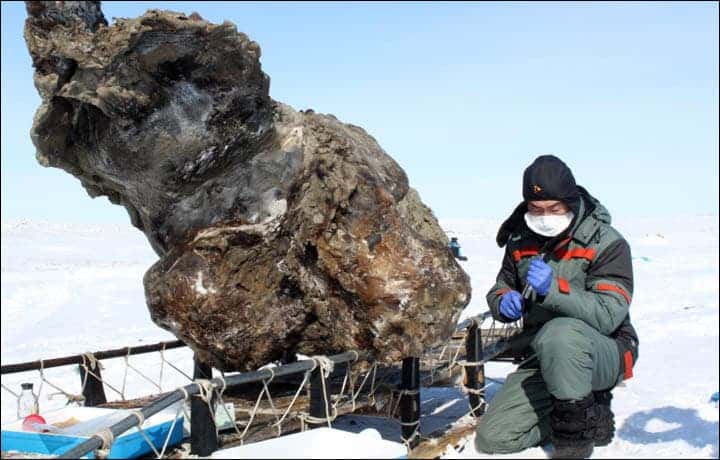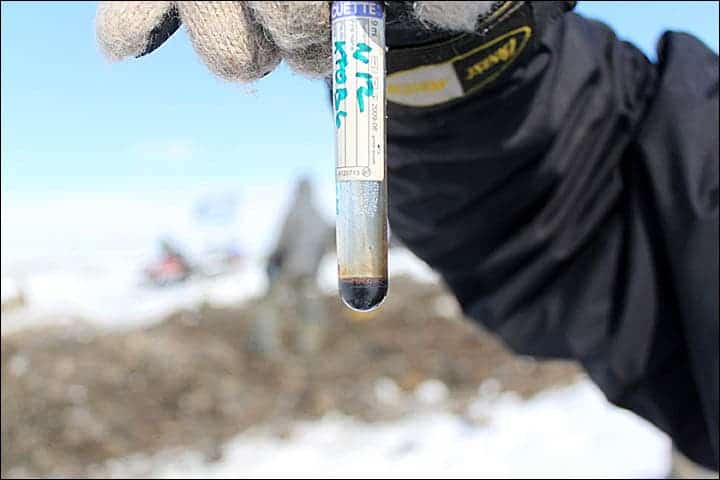
In nothing short of an astonishing find, Russian scientists have discovered a wonderfully preserved female mammoth carcass – the first in the world – in the icy tundra of Siberia. The muscle tissue was found to be extremely well preserved, but what simply caught the researchers by surprise, followed by the whole scientific community in the world, was the discovery of blood trapped in the ice. When the ice was broken, the blood flowed despite freezing -10 degrees Centigrade temperatures! It all sounds like the synopsis of a Hollywood adventure blockbuster, but it’s all as real as you and me.
The find was made in the Lyakhovsky Islands, the southernmost group of the New Siberian Islands in the Arctic seas of northeastern Russia. So far, only three adult mammoth carcasses, including the present discovery, have been discovered. The female mammoth carcass weighs about one ton, along with the bones and some ice, but the researchers assume that while she was alive, the female must have weighed about three tons. They believe she was between 50 and 60 years old when she died and must have lived from 10,000 to 15,000 years ago.

The degree of preservation is simply astonishing! The muscle tissue has been conserved so well by the icy cerement that it still had a natural red color of fresh meat. Such preservation can be explained by the fact that the lower part of the mammoth’s body was trapped in pure ice, while the upper part was discovered in the middle of the tundra. The trunk was found separately from the carcass. Nevermind the flowing blood…. that’s simply mind boggling! Now, why didn’t the blood freeze? Well mammoth blood, it seems, looks a lot like anti-freeze as mammoth haemoglobin let go of its oxygen much more readily at cold temperatures than living elephants today. The dark blood was found in ice cavities below the belly of the animal.
We were really surprised to find mammoth blood and muscle tissue,’ said Semyon Grigoriev, head of the Museum of Mammoths of the Institute of Applied Ecology of the North at the North Eastern Federal University.
‘It is the first time we managed to obtain mammoth blood. No-one has ever seen before how the mammoth’s blood flows’.
He explained: ‘The approximate age of this animal is about 10,000 years old. It has been preserved thanks to the special conditions, due to the fact that it did not defrost and then freeze again.
‘We suppose that the mammoth fell into water or got bogged down in a swamp, could not free herself and died. Due to this fact the lower part of the body, including the lower jaw, and tongue tissue, was preserved very well.
‘The upper torso and two legs, which were in the soil, were gnawed by prehistoric and modern predators and almost did not survive.’
The find comes amid intense efforts of resurrecting mammoths using DNA. Last year a deal was signed giving South Korean scientists exclusive rights on cloning the woolly mammoth from certain tissue samples found in the Siberian permafrost. Attempts so far have proven to be unsuccessful, since scientists have yet to isolate clean DNA. To get the DNA they need, scientists need a lot of living cells to work with and repair DNA. Grigoriev noted that the repair of DNA is a very complex process that can take years.
If eventually stable DNA is gathered, the plan is to implant eggs into the womb of a live elephant for a 22-month pregnancy. A mammoth should came out, but maybe something entirely new too.
Was this helpful?



